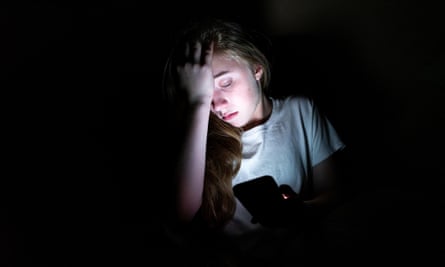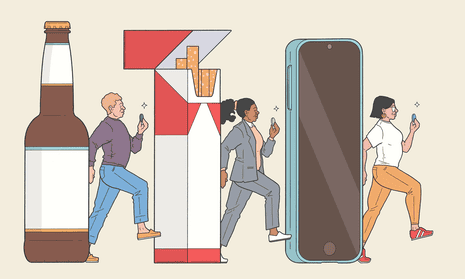“Hi, my name is Sarah* and I am an internet and technology addict.”
So began a meeting on a recent Wednesday afternoon, as 18 people quietly gathered on a Zoom call. Text in their small video boxes showed they hailed from locations as disparate as Oregon, India and Namibia.
Sarah and the other attendees are part of a growing fellowship called Internet and Technology Addicts Anonymous (ITAA), a 12-step program based on the principles of Alcoholics Anonymous that provides tools and support to deal with compulsive internet use. It launched with just a few founding US groups in 2017 and has quickly grown to have thousands of members around the world, with more than 100 online and in-person meetings in seven different languages.
Since Alcoholics Anonymous was founded in 1935, its 12 steps have been adapted for other addictions and compulsive behaviors including overeating, overspending and gambling. Now the traditionally abstinence-based program has been modified for a new drug of choice: our phones.
In meetings, ITAA participants who feel their technology usage has veered into destructive territory share their experiences and support one another in setting healthy boundaries.
Their troubles range from online shopping and compulsive social media scrolling to video-game addictions and television show bingeing. For most, the goal is not abstinence, but manageability.
Aubrey, a member of ITAA, said that when she attended her first meeting nine months ago, she was spending more than 12 hours a day cycling through different social media apps, compulsively posting and checking who had liked or engaged with her content. Her online habits were affecting her relationships and making it difficult for her to hold down a job.
“It felt like a gambling addiction, or a slot machine, because I was constantly refreshing my pages over and over again – I couldn’t stop myself,” she said. “Every single day I would tell myself: ‘OK, tomorrow I will stop.’ But I couldn’t. It was killing me.”
Defining boundaries
Internet and technology addiction is not recognized in the Diagnostic and Statistical Manual of Mental Disorders (DSM-5), the standard classification of mental disorders used by mental health professionals in the US – but research increasingly shows it features similarities to more widely recognized disorders like alcoholism.
One 2012 study of college students with mobile phone dependence tracked structural changes to the brain similar to what has been discovered in the brains of individuals with substance addictions. Leading addiction experts have said the dopamine cycle initiated by social media use mirrors that seen in drug users. A 2016 study of people suffering from gaming addiction found their neurological responses to gaming cues mirrored those seen in drug addicts experiencing physical cravings.
Unlike substance abuse disorders, internet and gaming dependence is considered a type of “behavioral” addiction. The only behavioral addiction recognized by the DSM-5 is gambling disorder, added in 1980. But such behavioral or “process” addictions have a number of similarities to chemical addictions, said Lawrence Weinstein, the chief medical officer at the American Addiction Center.
“Process addictions activate the brain’s reward center in a way similar to substances, but instead of a substance increasing levels of dopamine, the increase is caused by that particular behavior,” he said. “The pleasure obtained from that behavior reinforces that the individual will engage in it again in the future.”
Many people – both researchers and those affected by internet addiction – describe an experience similar to drug use disorders, which the DSM-5 characterizes by “impaired control, physical dependence, social problems and risky use”.
Such was the case for Aubrey, who said her compulsive social media use was “taking away her life”. She now attends daily meetings and considers herself sober from internet addiction – meaning she has stayed true to her self-imposed rules for responsible use. She is now able to hold a full-time job in a field she is passionate about – which, ironically, involves posting to social media on occasion.

While organizations like Narcotics Anonymous and Alcoholics Anonymous are based on an abstinence framework – one either drinks or does not drink – programs like ITAA are more nuanced, with each member determining their own definition of sobriety.
For Aubrey, a “bottom line” – program speak for a hard boundary whose violation would be considered a relapse into addiction – is checking likes on social media, scrolling her feed or watching Instagram stories. “Middle lines” are potentially triggering behaviors that should be navigated with care. Aubrey still uses the internet for work-related posts, while checking in with a sponsor in the program who holds her accountable.
“The program has given me tools with which I can navigate my internet usage in a way that aligns with my values,” she said. “Total abstinence is difficult, so you are really trying to discover a more healthy relationship with the internet and technology. It’s about finding support to abstain from the behaviors that felt really out of my control.”
after newsletter promotion
‘No longer a one-size-fits-all approach’
Studies show Alcoholics Anonymous is the most effective path to abstinence-based recovery from addiction, and the program has long been the gold standard in recovery medicine. But as methods such as harm reduction – which seeks to minimize the negative effects of substance use rather than eradicate it – gain in popularity, experts say there is a growing understanding that different people may need different resources.
“We no longer require a one-size-fits-all approach, which is how addiction treatment has been handled in the past,” said Emily Brunner, a Minnesota-based family medicine doctor who works in addiction treatment. “The most common way that we approach things now is to individually assess and match what works best for any patient.”
Still, most addiction specialists agree community support is integral to recovery. Apart from Alcoholics Anonymous and other 12-step programs, alternative groups have gained popularity – including Smart Recovery, Recovery Dharma and Celebrate Recovery.
“These programs – 12-step and non-12-step – provide structure, detail a path toward sustained recovery, combat shame and stigma, and offer connections with others who have the same desire to stop engaging in a specific addictive behavior,” said Amanda Lee Giordano, a professor of addiction counseling at the University of Georgia. “Oftentimes, peer support programs in conjunction with individual or group counseling is an optimal approach to treating behavioral addictions.”
Members of ITAA also are quick to say that 12-step programs are not the only path out of addictions like theirs – but they are often the cheapest and most accessible. Steven, a founding member of ITAA, said he hit his “rock bottom” six years ago when he was spending nearly all of his waking hours gaming, scrolling social media and bingeing online content – from podcasts to TV shows. Suicidal and hopeless, he searched online for help but found few resources in the US, aside from pricey rehab facilities.
In-patient treatment for drug and alcohol addiction ranges from $5,000 to $80,000 in the US, according to the directory site American Addiction Centers. Summerland, a digital detox camp geared towards children, costs nearly $12,000 for a seven-week retreat. ReSTART, an internet addiction rehab center for adults, charges $18,000 per month.
ITAA and other 12-step programs, meanwhile, are entirely free. Steven said the lack of resources for people like him underscores how misunderstood internet addiction is, with few resources dedicated to its research.
“It’s just like typical addictions, except the drug is dopamine,” he said. “But because everyone uses screens all the time, it’s very normalized, and it’s hard to have a clear sense of what is healthy or not. I don’t think our society likes to recognize the true nature of how harmful this can be.”
A staunch atheist, Steven said he was initially afraid to participate in a 12-step program because of its focus on finding a “higher power” – a common criticism of Alcoholics Anonymous. But he ultimately found the program strengthened his relationship to atheism.
“A really important part of being an atheist, to me, is a commitment to the truth,” he said. “I realized it was an illusion to believe I could control my addiction – to think I could outwill a neurological condition. I learned to accept non-judgmental support from other people who understand my problem and accept me.”
Steven said he recognizes there is some irony in finding so much support for his internet addiction in online meeting rooms – and certainly there are people in the program who prefer to only meet in person. But in many ways, finding help online reinforced for him some of the core tenets of the ITAA program.
“It’s not about cutting out technology – technology is really wonderful in a lot of ways. It’s about learning what is healthy and unhealthy for us personally,” he said. “It’s definitely possible to to get sober from the internet on the internet.”
* All names of ITAA members have been changed in this story to maintain anonymity in keeping with the traditions of the organization.
